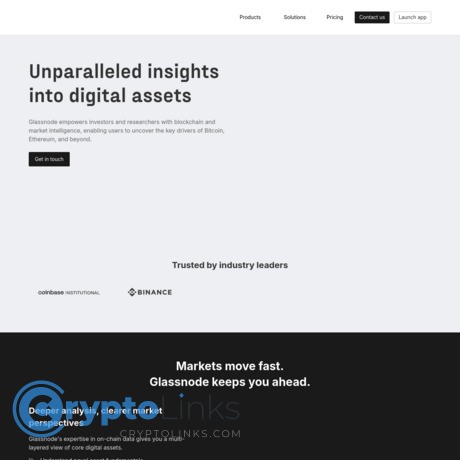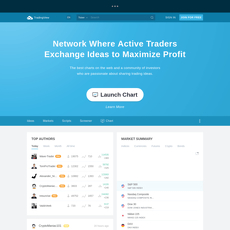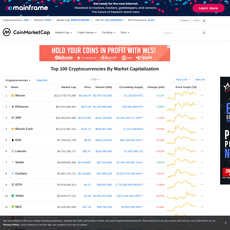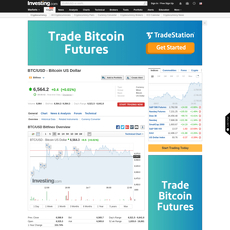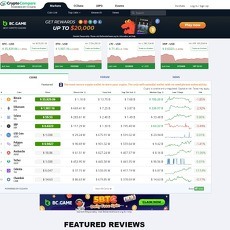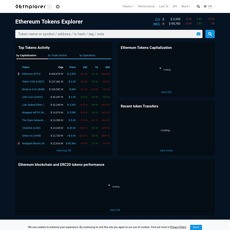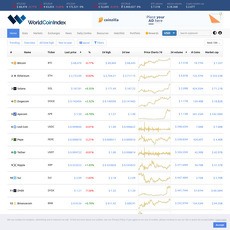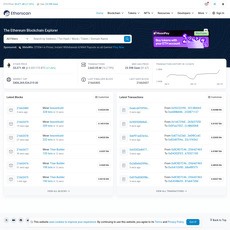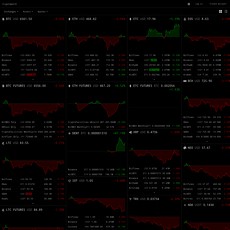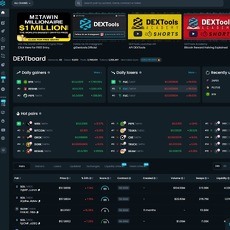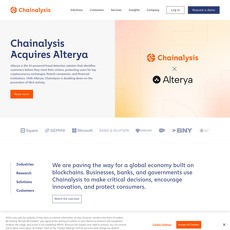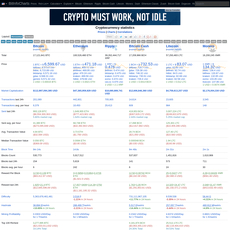Glassnode Review
Glassnode
glassnode.com
Glassnode Review: Everything You Need to Know with FAQs
Feeling lost in the overwhelming sea of crypto data? Struggling to figure out how to spot market opportunities or avoid risks? If you’ve ever wished for a tool that makes understanding blockchain data easier and helps you make smarter trading decisions, you’re exactly where you need to be.
What’s the Problem Glassnode Solves?
Let’s face it—managing crypto investments isn’t for the faint-hearted. Information flies at you from every direction: Bitcoin price variations, network activity, wallet movements, market sentiment… the list is endless. Without the proper tools, you're essentially guessing in a highly volatile space.
The problem? Most traders and investors don’t have the time—or the energy—to sift through heaps of raw data and try to make sense of it all. That’s where a gap emerges: tools that can simplify chaos into actionable insights.
Why Regular Tools Don’t Cut It
Most crypto tools on the market only scratch the surface. Price charts? Check. Trading volumes? Sure. But how about decoding deeper blockchain data? Wallet movements, network trends, long-term investor behavior—this is where many platforms let you down.
The issue is clear: these “regular” tools are great for surface-level information but fail to unlock crucial patterns hidden in the blockchain itself. Without insights into what’s happening on-chain, it's hard to stay one step ahead of the market.
Meet Glassnode, Your Data Solution
Enter Glassnode. This platform claims to be your go-to blockchain intelligence tool, providing insights directly from the blockchain itself. Whether you're a casual investor, a seasoned trader, or a hardcore hodler, Glassnode is designed to cut through the noise and give you exactly the data that matters.
Imagine having access to real-time insights on market trends, wallet activity, and risk signals—all in one place. Glassnode not only simplifies the data but turns it into something useful: actionable market intelligence.
Think about it. Wouldn't it be amazing to replace gut-based decisions with data-backed strategies? The days of second-guessing every market move could finally be behind you.
But how does it accomplish all this? How does Glassnode transform raw blockchain data into something even beginners can use with confidence? If you’re intrigued to know what makes it such a buzzworthy tool, hang tight. We’ll explore exactly what Glassnode does and how it works in the next section.
What Does Glassnode Do?
If you're serious about crypto, you know how overwhelming data can be. Prices jump, wallets move, and trends seem to shift overnight. Glassnode is the tool that makes sense of it all. No fluff, no noise—just actionable insights based on blockchain activity. Let me show you why it’s such a game-changer.
On-Chain Metrics Explained
Imagine being able to read the pulse of the crypto market right from the blockchain. That's what on-chain metrics are all about, and Glassnode takes them to the next level. These metrics track key movements—like how active wallet addresses are, who’s sending or holding coins, and where the patterns might be leading.
For example, say you want to know if a Bitcoin rally is sustainable. Glassnode’s active wallet data might reveal whether real people (and not just bots or whales) are participating or if there’s massive accumulation happening. These aren’t just guesses; they’re blockchain facts you can lean on.
Here’s one stat that blew my mind: A rise in the “Realized Cap HODL Waves” metric often signals long-term holders are cashing in. This could be your sign to brace for a market dip. These insights are pure gold for anyone trying to stay ahead.
Bitcoin Risk Indicator
Let’s be honest—crypto markets can be brutal. But what if you had a radar system to flag when Bitcoin might tank? That’s exactly what the Bitcoin Risk Indicator on Glassnode does. Using their unique blend of price movement, on-chain sentiment, and historical data, this tool throws up warning signals that can save traders from walking into a bloodbath.
Picture this: You’re thinking about buying BTC, but Glassnode’s indicator is flashing red. The dashboard shows you data on recent whale sell-offs and declining network activity. Sure enough, within days, the price nosedives. That’s the kind of power this tool brings—it doesn’t just show the “what”; it teaches you the “why.”
Making Smarter Decisions with Glassnode Insights
So how does all this data translate into decisions? Glassnode's clean, beautifully designed charts make it easy to see trends that help you time your moves. Want to know if it’s time to sell and lock in profits? Their Spent Output Profit Ratio (SOPR) chart can reveal when coins are being sold at a loss—a classic bear market signal.
- If SOPR values are dipping below 1, you might think twice before selling, as people are exiting weak positions.
- If holders are stacking up coins without moving them (as shown by the “Accumulation Trend Score”), it could be your sign to jump in before prices climb.
It’s not just about raw data but putting it into perspective. Glassnode strips away the noise and presents meaningful insights so you can act, not react.
“The goal is to transform data into information and information into insight.” – Carly Fiorina
And that’s exactly what Glassnode does—turns overwhelming blockchain raw data into clarity for traders and investors.
But here’s the thing: All this brilliance is useless if you don’t know where to start. So, how do you unlock Glassnode’s potential and tailor it to your own strategy? Keep reading, because next, I’ll walk you through exactly how to get started with this powerful platform.
How to Get Started with Glassnode
Thinking about giving Glassnode a try but unsure where to start? Don’t worry, I’ve got you covered. Getting up to speed with this tool doesn’t take long, whether you’re starting with the free tier or diving into the pro plans. Let’s break it all down step by step so you’ll be analyzing on-chain data in no time.
Free vs. Paid Plans
First off, let’s talk subscriptions. Glassnode offers multiple pricing tiers, so users at any experience level can benefit. Here's how the plans stack up:
- Free Tier: Perfect for beginners just exploring on-chain data. You’ll get basic metrics and limited access to charts. Great for dipping your toes in the water.
- Advanced Plan: This is for those looking for deeper insights, like detailed Bitcoin and Ethereum metrics. Think of it as the sweet spot for traders starting to take things seriously.
- Professional Plan: Want the full package? This is where you unlock premium features like historical data, real-time alerts, and access to reports tailored to expert users.
If you’re not ready to commit, start with the free version and watch how much easier it becomes to spot opportunities. As the saying goes, “You can’t master what you don’t measure.” And tools like Glassnode are designed exactly for that—revealing the unseen.
Creating Your Account
Getting started kicks off with creating your Glassnode account. The process is faster than you expect:
- Head to Glassnode’s website: You’ll find the sign-up button right on the homepage.
- Register: Add your email, create a secure password, and hit sign-up. Make sure you use an account you check often for updates and insights.
- Set Your Plan: Stick with the free version to get a feel for the platform or upgrade to unlock additional features.
Once you're in, you’ll quickly notice the clean and structured interface. No clutter, just raw Bitcoin and blockchain insights waiting for you to dig in. Feels empowering, right?
User Dashboard Basics
So now you’re signed up, what does the dashboard look like? Here’s where things get fun. Glassnode’s layout is built with traders in mind. The key areas you’ll want to focus on include:
- Metrics Panel: This is where you’ll access data like active addresses, exchange inflows, and wallet movements.
- Charts: Glassnode’s visual data is next-level. Interactive, detailed, and easy to grasp even if you’re new to chart reading.
- Search Bar: Quickly pull up the specific coins and chains you want to analyze. Bitcoin’s there by default, but Ethereum and altcoins are nicely integrated too.
Navigating the dashboard is painless, and if you’re a fan of customizing your experience, you'll love that many widgets can be tailored to your needs. Want Bitcoin exchanges only? Filter that. Prefer looking at long-term holder data? That’s one click away too.
Not sure where to start once you’re in? There’s one golden rule:
“Follow the data, not your emotions.”
In investing, emotional decisions often lead to mistakes. Glassnode’s dashboard is designed to help you stay objective by giving you hard data instead of hunches.
Now that you know how to set up and navigate Glassnode, you might be wondering how all that incredible on-chain data comes into play for analyzing the market. Curious where to start? Let’s explore exactly how you can use Glassnode to dissect blockchain trends with purpose.
How to Use Glassnode to See On-Chain Data
If you’re not leveraging on-chain data, you’re leaving money—and knowledge—on the table. The blockchain is like an open book, and platforms like Glassnode help you read between the lines. But here’s the kicker: understanding how to work with this data can transform the way you make decisions as a trader, investor, or enthusiast.
What is on-chain data?
Let’s start with the basics. On-chain data refers to real-time or historical information recorded directly on a blockchain network. Think of it as the raw footprints of every transaction, wallet movement, or miner action ever made. The cool part? All blockchains are public ledgers, which means this data is out there, waiting for you to decode it.
So, why does this matter? Because behind the numbers lies the story of market behavior. For instance:
- A surge in wallet activity? This might indicate whales are gearing up for big moves.
- A sharp drop in active addresses? A potential cooldown in market enthusiasm.
- High exchange inflows? Selling pressure could be increasing.
Glassnode takes these raw pieces of data and organizes them into understandable metrics. That’s the secret sauce. Without it, you might feel like you’re standing in front of a library with no idea where to begin.
As the legendary investor Peter Lynch once said,
“Know what you own, and why you own it."
In the crypto world, on-chain metrics give you that ‘why.’
Navigating data charts on Glassnode
Okay, let’s get into the fun stuff—reading the charts on Glassnode. When you log into the platform, the dashboard might seem overwhelming with its sea of metrics, but once you know what you’re looking at, it’s like treasure hunting. Here’s how to approach it:
- Start with the basics: Glassnode categorizes metrics into simple, intermediate, and advanced levels. For example, if you’re just starting out, check metrics like “Active Addresses”—this tells you how many unique wallets are transacting, which indicates market activity.
- Look at trends: Let’s say Bitcoin’s “Realized Cap” starts climbing. That’s a signal of stronger conviction among buyers. Or, if “Exchange Balances” are dropping significantly, investors might be shifting their BTC off exchanges into private wallets, a bullish sign.
- Choose custom time frames: Zoom out to see the bigger picture, like market cycles, or zoom in for intraday movements if you’re day trading. For example, during the 2021 bull market, weekly inflow and outflow changes told traders a ton about when the euphoria was starting to peak.
Glassnode doesn’t just throw numbers your way; it contextualizes them, helping you filter noise from the signal. With charts that analyze elements like miner behavior, HODL waves, or MVRV ratios, you can interpret market sentiment clearly and effectively.
Combining insights with your strategy
Here’s where the magic happens. The real value of Glassnode emerges when you combine its metrics with your existing trading or investing strategy. Why? Because no single tool is a crystal ball—it’s about connecting the dots.
Here are a few practical tips:
- Pair with technical analysis: Let’s say your charts show Bitcoin is nearing an important support level. Cross-check it with on-chain data like “Exchange Outflows.” Are more coins leaving exchanges? That could mean the support holds strong.
- Monitor supply shock indicators: Glassnode metrics like “Illiquid Supply” can highlight periods where a large portion of Bitcoin is held by long-term investors, reducing available supply. This worked as an early warning signal before past price rallies.
- Use alongside news: Major events like ETF approvals or regulatory crackdowns can be substantiated (or debunked) by real-time on-chain activity. For example, if there’s news about institutional buying, monitor Glassnode's “Institutional Inflows” metric for confirmation.
The beauty of Glassnode is its adaptability. This isn’t a one-size-fits-all tool—it molds itself to how you trade or invest. Still wondering how this can enhance your edge? How about seeing what features make Glassnode invaluable for Bitcoin and altcoins next?
Glassnode for Bitcoin and Altcoins
Let’s face it, Bitcoin may be the king of crypto, but the market is a vast ocean filled with altcoins that are just as crucial when building a balanced strategy. Whether you're a Bitcoin maximalist or someone chasing the next big wave, Glassnode offers a treasure trove of tools to analyze both Bitcoin and altcoins effectively. Let’s see how this platform becomes your secret weapon, no matter the coin you're tracking.
Bitcoin-Specific Features
When it comes to Bitcoin, Glassnode really shines. Many traders swear by its powerful Bitcoin-focused metrics. Some of the standout features include:
- Wallet Activity Insights: Curious if the whales are making moves? Glassnode tracks wallet sizes, looking at activity from small wallets to massive long-term holder wallets. For instance, if you notice a surge in new wallets (or conversely, whales selling large amounts), this could signal a major shift in market sentiment.
- Long-Term vs. Short-Term Holder Data: Glassnode splits the market into patient hodlers and short-term traders. Are hodlers stacking more sats despite a dip? That’s a bullish signal right there.
- Realized Price: This metric goes beyond the market price to give you a clearer view of what people are paying for Bitcoin on average. It’s a great way to gauge whether BTC is overbought or underbought.
Here’s the magic: These insights help you understand the "why" behind Bitcoin’s wild moves, not just the price action itself. It’s like looking under the hood of the machine that's moving billions of dollars every day.
"The trend is your friend, but on-chain data? That’s your edge." - Unknown trader legend.
Altcoin Tracking
It’s not just Bitcoin where Glassnode excels. Ethereum and other top altcoins have found their place on the platform as well. Altcoin traders constantly look for patterns, and Glassnode gives them the ammo they need, including:
- Ethereum Analytics: Like Bitcoin, Ethereum-specific data—such as gas usage, staking trends, and wallet balances—can help you assess market health and trends for DeFi ecosystems.
- Whale Alerts for Altcoins: On-chain data reveals when massive sums of a specific altcoin are being moved. Merge this info with other tools, and you could catch the next big pump before it happens.
- Activity Indicators: For smaller altcoins, tracking wallet creation, token transfers, or even NFT activity can uncover early trends before they gain mainstream traction.
For example, during a market downturn, Glassnode’s metrics might show rising activity for stablecoins like USDT or USDC. What does this tell you? Traders are moving into less risky assets, signaling caution. It’s actionable intelligence at its finest.
Multi-Chain Support and Updates
One of the exciting aspects of Glassnode is its constant evolution. While the platform started off as Bitcoin-heavy, it’s now extending its wings to more blockchains. Multi-chain support means you’re no longer limited to Bitcoin or Ethereum—you can analyze others as they’re added. This is especially useful as ecosystems evolve, whether it’s Solana’s rise in NFTs or Avalanche making waves in DeFi.
What’s wild is how seamless it feels. You get updates on coverage expansions, keeping you informed and ready for fresh opportunities. Imagine trading the next Solana-level breakout with actionable data before everyone else catches on.
Is it just me, or does a tool that works across multiple coins sound like a trader’s dream?
So, now that you’re equipped to conquer the world of Bitcoin and altcoins, one question remains: What happens if your strategy changes or you want to step back from paid plans? Stay tuned, because next, I’ll show you how to cancel your Glassnode subscription without any hurdles, and even give you tips on making the most of their free tools after. Ready?
How to Cancel a Glassnode Subscription
Let’s face it: circumstances change. Maybe you’re cutting back on expenses, or you’ve found another tool to try. Whatever your reason, canceling your Glassnode subscription doesn’t have to be some complex maze. Let me show you how easy it can be (and save you from pulling your hair out). You’ll even find a few tips to help you decide if canceling is truly your best option.
Cancelling Step-by-Step
First things first—Glassnode has streamlined the cancellation process. But here’s the kicker: the option is located under something they call the “Danger Zone.” Yes, it sounds dramatic, but it’s essentially their section for account adjustments that could have big consequences (like downgrading or deleting accounts).
Here’s how to cancel:
- Log in to your Glassnode account and head over to “Settings.”
- Scroll down until you find the “Danger Zone.”
- Select “Cancel Subscription.”
- Follow the prompts to confirm your decision. You might be asked why you’re leaving—optional, but it helps them improve.
And that’s it! The process is surprisingly straightforward. Just a couple of clicks, and you’re done. But what happens next? That’s where the refund policy comes in.
Refund Policy Explained
If you’re wondering whether you’ll get your money back after hitting that cancel button, the answer depends on your plan. Based on their terms, Glassnode does not offer prorated refunds for mid-billing cycle cancellations. In simpler terms: if you cancel halfway through the month, you’ll still have access until the end of your billing period, but there’s no partial refund for the unused days.
This policy pushes you to carefully consider whether now is the right time to cancel. If you’re close to your renewal date, it may benefit you to make the change just before the new cycle begins so you get maximum value out of what you’ve already paid for. Plan wisely.
Alternatives Post-Subscription
If canceling is more about cutting costs and less about dissatisfaction, you’ve still got options. What if you could keep some of the benefits without paying the full price? Glassnode offers a free plan that includes limited access to analytics, charts, and tools.
Other alternatives:
- Downgrade to a lower-tiered subscription if you just don’t need the advanced metrics anymore.
- Use other free tools like CryptoQuant or blockchain explorers for basic data insights.
Canceling doesn’t have to feel like a dead end—it could just be one step in recalibrating your strategy.
“Don’t be afraid to change your plans. Flexibility is often where growth begins.”
Speaking of plans, are there better ways to maximize Glassnode’s insights before calling it quits? What if you’re not using it to its full potential? Let’s explore this (and more frequently asked questions) up next.
Common FAQs About Glassnode
Is Glassnode worth it for beginners?
If you're just stepping into the world of cryptocurrencies, you might wonder if Glassnode is the right tool for you. Here's the deal: Glassnode can be incredibly valuable for beginners, but it depends on what you're looking for.
For someone new, the platform’s free tier offers a fantastic start. It provides a variety of metrics and insights without overwhelming you. If you're trying to grasp the basics of the market—like understanding whether there are large holders buying or selling—it’s a goldmine of information. But, if you're not willing to spend some time learning the ropes, it might feel a bit complex at first. Remember, even the best tools won’t do the thinking for you—they’re there to empower you.
As an example, imagine you’re holding Bitcoin and see a sudden spike in the number of active wallets. For a beginner, that may not mean much, but with Glassnode’s insights, you'd quickly learn it might signal increased market interest—and perhaps a price shift is coming. If you're serious about better decisions in the market, I'd say it’s worth giving it a shot.
How do you interpret Glassnode’s complex data sets?
This question pops up all the time: "There’s so much information—how am I supposed to make sense of it all?" Don’t worry; you’re not alone. Glassnode's data can look intimidating at first glance, but it’s all about knowing where to focus.
Here’s a trick I always recommend—start simple. Look for metrics like Active Addresses or Exchange Inflow. For instance, are more coins moving to exchanges? That could mean people are gearing up to sell, which could impact the price. The platform also includes helpful guides and explanations for each metric, so you don’t have to guess.
Another great feature for making sense of insights is their color-coded charts. They visually highlight trends like market bottoms or tops. A good example is the Bitcoin MVRV-Z Score. Sounds fancy, right? But when the score gets too high, it often points to a market that's overheated—and gives you a warning sign.
Glassnode’s data isn’t just about complicated math; it’s about telling a story with numbers. And once you tune into that story, you’ll start spotting market patterns that others miss. As someone said, “Numbers don’t lie, but they don’t speak unless you know their language.”
Are Glassnode metrics reliable?
This is where people often hesitate—how much can you rely on what the platform tells you? Let me be straight: Glassnode has built its reputation on the accuracy and depth of its insights. They pull data directly from public blockchains, which makes their info as reliable as the technology itself.
Take the Bitcoin Long-Term Holders metric, for example: It tracks how many coins are held for a long period of time without being sold. Historically, when there’s a rise in long-term holders, Bitcoin tends to show greater price stability. With a track record of accuracy like that, it’s no wonder many traders and analysts swear by Glassnode’s tools.
That being said, no tool is perfect. Metrics are there to guide you—not guarantee results. Markets are shaped by unpredictable human emotions and events too. However, if you’re looking for reliable, high-quality data, Glassnode is among the best you’ll find today.
The metrics also undergo constant development and updates, ensuring they stay relevant in an ever-changing crypto environment. This constant evolution adds a layer of trust that Glassnode isn’t just creating numbers for the sake of it—they’re serious about backing their claims with real, actionable blockchain data.
"Accuracy is the heartbeat of great decisions, and in crypto, every heartbeat counts."
Still wondering how Glassnode stacks up against other platforms out there? Could another tool fit your needs better, or does Glassnode truly reign supreme? Let’s check out some alternatives next to find out.
Alternative Platforms and How Glassnode Stacks Up
Other Big Names in the Game
Let’s face it: Glassnode isn’t the only player in the crypto analytics space. Big names like CryptoQuant and Santiment are making waves too. CryptoQuant, for instance, is known for its focus on exchange flows and miner activity data. This can be useful if you're keeping a close watch on liquidations or major market moves prompted by whale activities. Meanwhile, Santiment shines with its social metrics—tracking trader sentiment, social buzz, and even Github updates for certain projects.
Each of these platforms has its strengths that appeal to different types of users. But here's the crucial question: how does Glassnode compare? Let’s explore that in the next section.
Why Glassnode Stands Out
What makes Glassnode special isn’t just the quality of the data—it’s how easy it makes complicated blockchain info to understand and use. Most competitors serve you raw numbers and expect you to figure out what it means. But Glassnode? It converts all that into actionable insights that even a non-wizard with charts can get value from.
Take the Bitcoin Risk Indicator as an example. While other platforms might show you raw Bitcoin outflow charts and let you guess when the top is near, Glassnode’s proprietary algorithm takes these raw signals and distills them into a clear risk score. Your job? Simply look at whether the signal suggests high or low risk and plan your moves accordingly. No guesswork involved.
Another area Glassnode nails is its ability to filter out noise. With crypto data, it’s easy to get overwhelmed by irrelevant or redundant information, but Glassnode’s metrics are laser-focused on what really matters. That kind of “clarity in chaos” you rarely see elsewhere.
Wrapping It Up: Should You Use Glassnode?
Is it right for you?
If you're serious about understanding what's happening behind the scenes in crypto, Glassnode might just be the tool you need. Whether you're an investor tracking long-term opportunities or a trader looking for the perfect moment to make your move, its ability to transform complex blockchain data into actionable insights is a game-changer.
Here’s the thing: the crypto market is chaotic by nature. Wallet movements, exchange inflows, market sentiment—it’s a puzzle. Glassnode solves that puzzle by delivering the clarity you need to navigate this space intelligently. Even if you’re just starting out, its user-friendly platform makes getting insights straightforward, without drowning you in charts you don’t understand.
Quick pros and cons recap
To help you decide, let me lay out the good and the could-be-better:
- Pros:
- Detailed on-chain data that feels like having a secret weapon for trading.
- A range of plans, including free options, so you’re not pressured to invest big upfront.
- Metrics that go beyond price to uncover market trends and investor behavior.
- Cons:
- Some of the advanced data is locked behind higher subscription tiers, which might discourage new users.
- If you’re not yet into on-chain analysis, it might feel like too much information at first.
These aren't deal-breakers though. I’d argue that the power of the free version alone makes it worth exploring. And if you're committed to crypto as a long-term game, the pro levels can unlock insights that tools like trading platforms simply can’t provide.
Final thoughts for crypto users
At the end of the day, Glassnode is built for one purpose: to help you make smarter decisions. It gives you the bigger picture so you’re not just basing trades or investments on hype or gut feelings. The transparency it offers into Bitcoin, Ethereum, and other major blockchains is something every crypto enthusiast can benefit from.
Whether you’re planning your next move or just keeping an eye on market sentiment, Glassnode empowers you with facts, not guesses. If you're tired of second-guessing your decisions or constantly reacting after the market makes big moves, this platform could be your missing tool.
So, where do you stand? Are you ready to step up your game with Glassnode’s insights? There’s no need to guess when you can make informed moves. The blockchain never lies—Glassnode just helps you read its story. It’s time to make crypto work for you.

